How a solar-powered plane made it around the world without a drop of fuel
Solar Impulse 2 is a solar-powered airplane. It has a greater wingspan than a 747 but only the weight of a car. This morning, it landed in Abu Dhabi, completing a flight around the world without using a drop of fuel.
It wasn’t exactly a nonstop flight — it’s taken a year and five months to finish the trip. (It’s had a couple of breakdowns, it must fly in calm weather, and its top speed is 55 miles an hour.)

Nonetheless, the project shattered all kinds of records and, in the end, fulfilled its real mission—to highlight the promise of clean technologies.
Yesterday, “CBS Sunday Morning” aired my interview with the two men who created and flew the plane (you can watch it online here). But as always, the interview was much longer and richer than TV has time for. So here, for your pleasure, its my edited interview with André Borschberg (left) and Bertrand Piccard (right) — a fascinating conversation about disruption, technology, common wisdom, and the future.

David Pogue: What was the aviation industry’s reaction to the idea of this plane?
André Borschberg: They told us that it is impossible.
Bertrand Piccard: It’s completely normal that the aviation world didn’t believe in it. They have learned to make specific airplanes, to reproduce what they have done all their life. It’s not the people who were selling candles who invented the light bulb.
AB: You know, when you want to make a disruption, you have to look for different solutions. I want to give you an example. We knew that the structure had to be built in carbon fibers. So I looked for the company with the best knowledge of the material.
And it was a boat builder! Not any kind of boat — the guys who designed and built the boats that won the America’s Cup for Switzerland in 2003 and 2007. Very innovative, extremely good knowledge about carbon fibers.
But when I brought this company to my team, my engineers said, “Are you crazy? These guys don’t understand anything about aviation!”
And on the other side, the boat builders told me, “Your engineers are great, but they have no idea about carbon fibers. This will never work!” It took me more than two years to create a bridge between the two teams.
DP: But neither of you had ever built a plane, had you?
AB: No. But it’s an advantage in this situation. Because we were not bounded by the solutions that we knew. We could be open to anything.
BP: If you are told it’s impossible, the people you attract to the team are creative people. If it’s a conventional project, you bring conventional people.
DP: It’s great that you’re outsiders. But that might also have meant that it can’t work!
BP: Of course we questioned ourselves. We had doubts, we had setbacks. But this is exploration. Exploration is not when you wave the flag of victory. Exploration is when you go into the unknown, you have no idea what’s going to happen, and you try to use the doubt to stimulate your creativity and your imagination process.
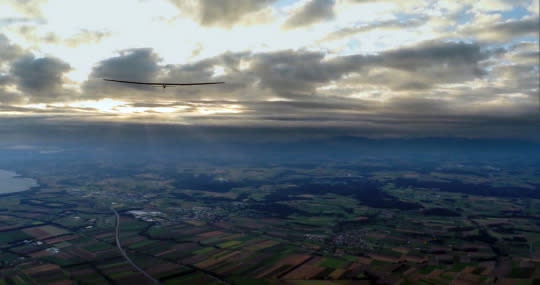
The Mission
DP: At its heart, Solar Impulse is meant to be a demonstration of clean technologies, right?
BP: Yes. If you take all the challenges that Andre’s engineering team had to build a plane, it’s exactly the challenges that our world has to be cleaner: insulation, LED lamps, intelligent use of energy like in smart grids. And all this could, today, already, cut in half the energy consumption and the CO2 emissions of the world.
DP: But you understand, don’t you, that there are people watching you right now going, “Oh, blah blah blah, climate change, these liberal European guys. There’s no climate change! Or if there is, it’s all natural.”
BP: I’m not here to say that climate-change deniers are right or wrong. I’m just saying that even if there was no climate change in this world, it would make perfect sense to replace the old polluting devices — like combustion engines, old insulation of houses, inefficient heating, and all that — with efficient technologies, because it’s a new industrial market. People will make profit. They will make job creation. They will sustain economic growth.
A Tour of the Cabin
Piccard gave me a tour of the plane’s cockpit.

BP: In some ways, you fly the plane like any plane, except that it has a lot of inertia, lot of adverse yaw. So it’s quite challenging when it’s turbulent. It’s not easy to fly.
DP: How do you go to sleep?
BP: You put the seat back like this here [it folds backwards, flat]. You switch on the autopilot. You tell the team that the plane works well. You set the alarm clock for the 20 minutes. And I lie down like this.

DP: Wait. 20 minutes?
BP: Yeah. Twenty minutes at a time.
DP: Why only 20-minute naps?
BP: Because we thought that 20 minutes is the best to avoid going into very deep sleep that is difficult to get out of. And, if it’s only 20 minutes, even if the autopilot disconnects, you don’t drift too much.
DP: And you can do that for four or five days?
BP: Yeah. What helps is self-hypnosis. You just try to dissociate yourself from the outer world. I use a way where I focus on the fingernail of my thumb until I see nothing else. Then I take a big breath, I roll my eyes and I go back.
DP: And what about exercise?
BP: It’s very important that you can keep the blood circulation correctly in the body. The best thing to relax is to put the feet up there like this [leans back, puts his feet on the ceiling].

DP: Yeah. I tried that on Delta once. They didn’t like it.
BP: They don’t like it? (LAUGH)
DP: There’s actually a lot of room in here.
BP: Yes, yeah. It’s a little house. In addition to flying, you cook your food, you go to the toilet, you brush your teeth, your sleep.
DP: Wait — you cook your food how?
BP: We have some special Nestle packages that have a chemical reaction in the package. So when you add a little bit of water, the chemical reactions makes heat, and it heats up your curry chicken, your rice with — mushrooms, your potato.
DP: And forgive me, but you did say you somehow go to the bathroom?
BP: Absolutely. You have a toilet bag here under your seat [it hinges open].
DP: Oh, I see. So you’re basically sitting on a toilet for five days?
BP: You’re sitting on a toilet. You can see it this way. (LAUGH) But you can also say that you have the best view in the world from the toilet. And you don’t need to pull the curtains for privacy, because nobody’s flying next to you.
DP: And what about the in-flight movies?
BP: The in-flight movie is not on the screen. It’s the view outside. So when I’m flying, I’m not going to try to find a distraction. I want to enjoy it. I want to be aware of it.
DP: Is there a lot to do technically?
BP: At sunrise, you switch on the solar panels. You receive all the briefings from the mission control center in Monaco. Then it’s the morning. You eat breakfast, this is beautiful. Cereals, pour the milk, you add some water, fruit. And then you have a little bit of time for interviews and for the gym.
As soon as you need to climb, you have to put the oxygen mask. You test it completely. Then you climb. You have all the checks through the different altitudes. You arrive at 28,000 feet. I take notes. I don’t read anything, because I don’t want to be distracted, but I write a lot of things for the book that we’re preparing with André.
Then as soon as the sun starts to decline, you need to manage your energy very carefully. Because if you leave the throttle too high, you start to discharge your batteries. And then you start to glide for four hours, with its engines idle.
And then you arrive 5,000 or 6,000 feet at about 11 at night. And you know that you are at this altitude for the next eight or 10 hours, and then you try to sleep.
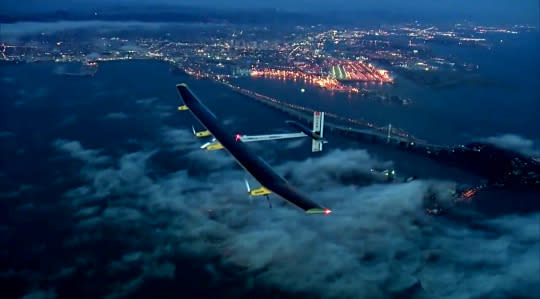
I take a lot of pictures also. Because you think that it’s only sky, water and clouds, but actually that’s not true. Sometimes you see some rain around you or below you. You have the sky — you cannot imagine what the sunrise looks like. It’s fully black, and then you have a silver line coming, and then the top becomes pink. And suddenly you have the sun coming, and it brings all the colors to everything below. It’s beautiful.
DP: What kind of contact are you in with Monaco [mission control] and the rest of the team?
BP: Monaco, it’s a hot mic. If I’m taking my breakfast and the milk is falling on my flight suit, and I say, “Oh, sh**, what happened?” They say, “Uh, be careful. There are 2 million people listening live on internet. Watch your language.”
DP: Do you have a parachute?
BP: Yeah. You wear the parachute all the time.
DP: And then how would you get out?
BP: Just push the door open with your foot, and
you jump.
DP: Wow. Well, thank you, Captain Piccard.
BP: You know Captain Picard from “Star Trek”
is named after the twin brother of my grandfather.
DP: Really? Oh, so that’s not just a coincidence?
BP: No, no. My grandfather made the first stratospheric flight ever. And then his twin brother, who lived in the U.S., made the first stratospheric flight in the US. And he got very famous also in the U.S. And the creator of “Star Trek” took him as model for the Captain Picard of the enterprise.
DP: That’s very cool. But he misspelled it.
BP: He did it on purpose. He explained to my cousin that he took only one C instead of two C’s not to have any legal problem with the family. (LAUGH) And we told him, “Well, you could have spelled it right! There’s no problem. It’s an honor.”
A Tour of the Plane
André Borschberg, the engineer, walked me around the plane’s exterior.

AB: Everything is designed to save energy. That’s how we fly a week, potentially maybe a month. It’s almost a hybrid system, altitude and battery. So during the day, we charge the batteries and climb to 28,000 feet.
Altitude is another way to store energy. Altitude is potential energy. When I’m very high, I can glide down. I don’t need the engine. After four hours, then I use the energy from the batteries.
But flying up high also takes you above bad weather, brings you above high mountains. And maybe you hold for awhile, to let bad weather pass by and continue. So again, no dependence on electric energy.
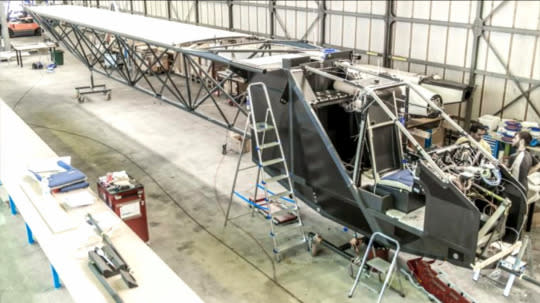
The wings have a structure made of layers of carbon fibers, like our bones. One layer weighs a third of the weight of a sheet of paper. The solar cells are not glued to the surface — they are the surface. Again, that’s how you make it extremely extremely light.
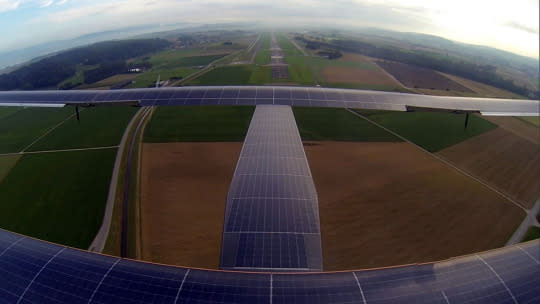
DP: How do you land?
AB: We have one single main landing gear [wheel]. So when we land, we have to be well balanced. When we stop, we have people on electric bicycles. They ride up to the plane as we slow down on the runway and grab the airplane on each side — the wingtips.
Interestingly, in fact, this wheel can turn [relative to the plane]. So if we have cross-wind, the airplane can land at a crab angle. We don’t have to de-crab. We just roll down the runway at that angle, which is quite strange as a pilot. But this solution works extremely well.
DP: What’s the top speed?
AB: So the best speed is 24 knots [27 mph]. But this is at sea level. It goes faster when you are higher, because the air density diminishes. The maximum seed is about 50 knots — 55 miles an hour.
DP: This thing only goes as fast as a car?
AB: Twenty-four hours a day. You don’t have to go down to refuel. You just keep going. The goal is not how fast you go to the destination. It’s how you get to the destination.
The Partners
DP: Tell me about your relationship. Is it like a marriage? Is it like old buddies? Do you fight?
BP: Sometimes we fight, but not very often. I think in the 13 years that we’ve worked together, maybe we screamed at each other four or five times. But we very often disagree, which is the source of our creativity.
We are so different. He’s an engineer, I’m a medical doctor. He’s a jet fighter pilot, I’m an explorer. Andre comes with one vision of the world. I come with another one. And when we combine our visions of the world, we have a third one. So it’s a relation where one plus one equal three.
AB: I’ll give you one example. Bertrand is a person who will wait until the last minute to make a decision, because he wants to incorporate every possible opinion. Which is great, but it makes it
difficult for the people who work with him.
I’m on the other side. I will prepare strategy, prepare a plan, of course, share it with the team– maybe with the risk of missing certain inputs. But if you combine both — the plan, the strategy, the thinking, the intuition, then you have an optimum solution.
It’s not easy. Don’t think it’s easy. I mean, we need to — what I call clean the tank — you know, share frustration or disagreement from time to time. So we say, “Okay, let’s take an hour or two hours,” and we discuss in a corner. And then, you know, we explain to each other, we share our feelings, and then we come a clean situation which allows us to continue.
DP: So what’s the next step?
AB: Our next project is an unmanned plane, which would be so much lighter that it could fly six months nonstop, so high that it will be above the clouds. That could be ready in about three three to four years.
DP: Why an unmanned plane?
AB: It could replace satellites in a more flexible, sustainable way. You can bring these up in down, change the equipment. You can position it any way, any time, instead of satellites rotating all the time and not being at the right place at the right moment.
BP: Maybe they will be soon airplanes that can transport two or three people on solar energy.
DP: So you’re saying this is only the first step?
BP: That’s the first step. The Wright brothers, they also had a single-seater flying very slowly in good weather. And 66 years later, there were two men on the moon.
DP: You have a point. (LAUGH)
BP: I make the bet with you that in less than ten years’ time, we have electrical airplanes transporting 50 people for 1,000-mile trips. And this will happen. And you know why? Because they will be able to land in the cities or very close to cities at night, disturbing nobody with no noise and no pollution.
DP: You’re willing to make that bet?
BP: Yeah. I make that bet. Absolutely sure.
DP: All right, here we go. Ten years right back
here?
BP: Yes, yes. (LAUGHS)
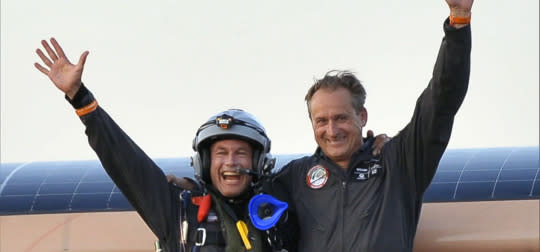
David Pogue is the founder of Yahoo Tech; here’s how to get his columns by email. On the Web, he’s davidpogue.com. On Twitter, he’s @pogue. On email, he’s poguester@yahoo.com. He welcomes non-toxic comments in the Comments below.

 Yahoo Finance
Yahoo Finance 